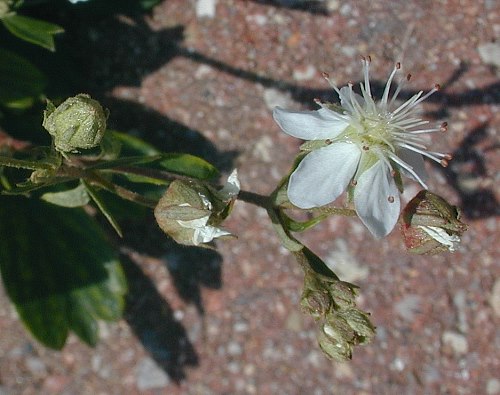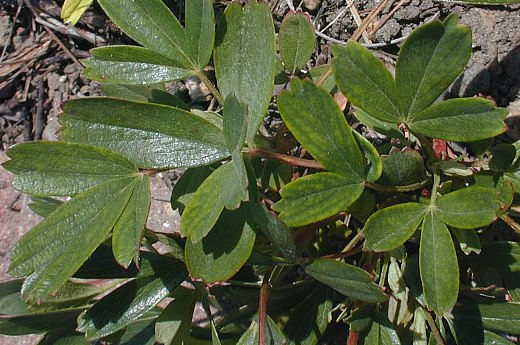Description: This perennial wildflower is woody at the base and only 4-10" tall. The lower stems have shredded bark that is grey-brown, while the upper stems are non-woody and light green to red. Most branching occurs toward the base of each plant; the stems have a tendency to sprawl across the ground as they become longer. Alternate trifoliate leaves develop primarily from the base of each stem. Individual leaflets are up to 1½" long and ½" across; the middle leaflet is usually longer than the 2 lateral leaflets. The shape of each leaflet is oblanceolate, terminating in a truncate tip with 3 large teeth. The leaflets are evergreen with a somewhat thick leathery texture; their upper surfaces are medium to dark green and shiny, while their lower surfaces are pale green and often slightly pubescent. During the winter, the leaflets often become tinted with red. Each trifoliate leaf has a long petiole up to 2" long; this petiole is light green to red and it has a pair of large linear-lanceolate stipules at its base. Some of the upper stems terminate in cymes or compound cymes of 1-12 flowers. Each flower is up to ½" across, consisting of 5 white petals, a light green calyx with 5 ovate teeth, a dense cluster of pistils, and 20-30 stamens. Adjacent to the calyx of the flower, there are 5 light green bracteoles (tiny bracts); these bracteoles are linear-oblong and shorter than the teeth of the calyx. The slender white styles of the pistils spread laterally from the center of the flower. The branches of each cyme are terete, light green, and often pubescent. At the base of each fork in the cyme, there is a pair of small lanceolate bracts.

The blooming
period occurs during the summer and lasts about 2-3 months. At
maturity, each flower produces a cluster of hairy brown achenes. The
root system is woody and can produce vegetative offsets from
underground runners. Older plants may produce a caudex.
Cultivation:
The preference is plenty of sun, dry conditions, and well-drained soil
that is rocky, gravelly, or sandy. This plant can adapt to a rock
garden if it is sunny and well-drained. Because this is a boreal
species, it dislikes excessive heat during the summer.
Range & Habitat:
In Illinois, Three-Toothed Cinquefoil has been found only in Cook
County (see Distribution
Map), where it was probably native. Because this species has
not been observed in any
natural area of the state since 1895, it is probably extirpated within
the state. The habitat of Three-Toothed Cinquefoil in Illinois was a
gravel hill prairie. Outside of the state, it is found on treeless
mountain tops and other upland rocky areas that are sunny; it also
occurs along sandy banks. The range of this species extends from the
upper Great Lakes to New England, and then northward to the Arctic
Circle of Canada and Greenland. Small isolated populations still occur
in the Appalachian Mountains as far south as northern Georgia.

Faunal
Associations:
Because this species is quite rare in Illinois and the surrounding
area, information about floral-faunal relationships is unavailable.
Like similar Potentilla spp. (Cinquefoil species),
the flowers probably attract small bees and Syrphid flies.
Photographic Location:
A rock garden at the Arboretum of the University of Illinois in Urbana,
Illinois.
Comments:
Another scientific name of this species is Potentilla
tridentata. Three-Toothed Cinquefoil was reclassified into
its own genus as a result of genetic analysis, which revealed that it
was more closely related to another boreal species, Sibbaldia
procumbens (Sibbaldia). The trifoliate leaves of this latter
species are similar to those of Three-Toothed Cinquefoil, but the
flowers of Sibbaldia are less showy because of the small size of the
petals. Three-Toothed Cinquefoil differs from Potentilla spp.
by the lateral styles of its flowers; it also differs from many of
these species by its woody lower stems and evergreen leaves.